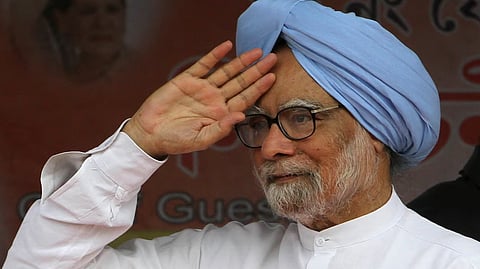

Forever seen in his signature blue turban, it’s rare to find a leader who blends humility, intellect, and steadfastness quite like Dr Manmohan Singh.
From the quiet scholar to a leader who made his mark on Indian politics through a truly personal approach, Singh’s legacy is a masterclass in the ‘Indian Dream’.
Singh was born September 26, 1932, in Gah, Pakistan (then, India), and survived the bloody Partition with grit with his family, migrating from Pakistan for India.
From such grounded starts, one could hardly guess he’d earn a first-class Economics degree from Cambridge University and a DPhil from Oxford in the 1960s. Singh's journey serves as a humble reminder that with the right recipe of hope, integrity and a lot of hard work anything is possible.
For students, his trajectory serves as a reminder of the power of education and persistence.
Before he became the chief architect of India’s economic liberalisation in 1991 under Prime Minister PV Narasimha Rao’s government, he had held every top economic role: Chief Economic Advisor, Deputy Chairman of the Planning Commission, Governor of the Reserve Bank of India, and Union Finance Secretary.
In his iconic 1991 speech, Dr Singh, ever the picture of seeing the long-term result, said on the floor of the House of the People, “When we embarked on this path, we knew that the benefit of our policies would only be seen after three to four years. Patience is, therefore, essential.”
His 1991 Budget, presented as Finance Minister under Prime Minister PV Narasimha Rao, transformed India from an insular economy to a global powerhouse. The effects of liberalisation will resonate for as long as our country stands, in every McDonald’s Big Mac, every international education opportunity, every snapshot shared on Instagram, and every H&M sweatshirt.
His varied roles propelled him to handle India’s financial crisis, as Prime Minister, in 2008 with precision.
His decade-long tenure as Prime Minister, though heralded as a stint of weakness, was equally transformative, from championing the Indo-US nuclear deal to overseeing the implementation of several transformative initiatives, including the National Rural Health Mission, the establishment of the Unique Identification Authority, the Rural Employment Guarantee Scheme, and the enactment of the Right to Information Act, the ripples of whose implementation is felt to this day.
He navigated political opposition and his party allies, reinforcing India’s status on the global stage.
However, leadership is rarely without criticism. His time in office saw allegations of corruption (2G, coal block allocation, Commonwealth Games) and accusations of “policy paralysis” which ultimately led to the fall of the UPA coalition in 2014. these controversies overshadowed his achievements, but Dr Singh’s response was dignified: “History will be kinder to me than contemporary media or the Opposition.”
Perhaps the most relatable aspect of Dr Singh’s life for students was his resilience in the face of criticism. Despite being mockery, Former US President Barack Obama’s words at a G20 summit encapsulate his global stature: “When the Prime Minister speaks, people listen.”
Indeed, today, his legacy is being revisited with admiration.
Dr Singh’s career also reminds students about the importance of adaptability. With the rise of MS, gone were the days of Nehruvian non-alignment ushering in an era of equitable relationships with global powers, which continues today. He even pursued dialogue with Pakistan under challenging circumstances, demonstrating that progress often requires stepping outside his comfort zone.
Dr Singh’s story teaches us that leadership isn’t always about charisma or rhetoric. It’s about consistency, hard work, and a clear vision.
As students navigate their paths, his life is a reminder that determination in its quiet form, can be just as impactful, if not more so, as a confident speech in a rally of thousands.
Dr Manmohan Singh, India’s fourth longest-serving Prime Minister, passed away on December 26, 2024, in All India Institute of Medical Sciences (AIIMS), Delhi, at the age of 92, leaving behind a legacy of economic transformation, political courage, and personal humility. His life is an inspiration to every student striving to make a difference in their unique way.
(Tarun Tapan Bhuyan is a student of SAI International School. Views expressed are his own.)
